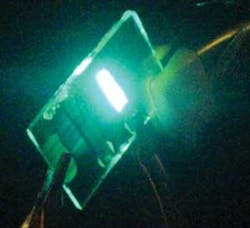CNT electrode for OLED displays is transparent and flexible
Multiwalled carbon nanotubes (CNTs) are the basis of a transparent electrode that researchers at the University of Texas at Dallas have developed for use in high-brightness organic light-emitting diodes (OLEDs). While the electrode was tested on a glass substrate, one of its advantages lies in its usefulness for flexible OLED displays. The conventional OLED transparent electrode, indium tin oxide (ITO), is a ceramic, and develops defects if flexed too much. In addition, fabricating ITO films, especially of the high quality needed, is an involved process, unlike the simpler CNT electrode fabrication.
A freestanding CNT sheet 20 µm thick was placed on glass and the combination dipped in ethanol and dried, which densified the CNT sheet to a 50 nm thickness, forming the device’s anode. Layers of an organic hole-injecting material and the OLED materials were deposited next, followed by patterned cathode layers (the cathode is behind the OLED and thus does not have to be transparent). The resulting device showed a brightness of 4500 cd/m2 and a current efficiency near 2.5 cd/A–close to the efficiency of a similar device with an ITO anode. Decreasing the CNT sheet’s resistance should boost efficiency above that of devices using ITO, say the researchers. Contact Anvar Zakhidov at [email protected].

